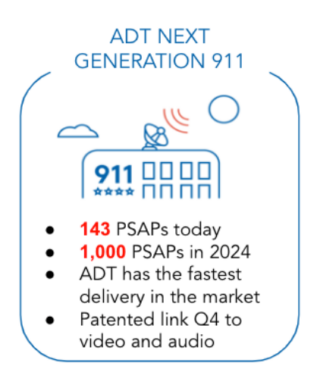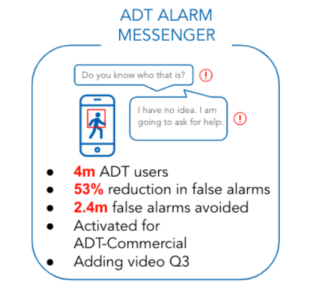
Alarm monitoring has evolved and matured markedly over the years. For ADT, those years number 145, as the company has been working to protect homes longer than any other in the industry! There have been exponential advancements in monitoring technologies over all those decades, so it made good sense that ADT presented a peer-to-peer educational session at ESX in June that explored some of the most important innovations impacting modern day monitoring capabilities.
ADT Security’s Vice President of Monitoring Technology, Larry Folsom, led this “Monitoring Innovation in Action” session. He was joined by co-presenters Anthony Iannone, Director, Affiliated Monitoring, Nicole Pitts, Calipsa’s Account Director for the Americas, and John Chiaramonte, President, Consulting Services, Mission Critical Partners.
The four presenters offered various perspectives from different facets of the industry, which enabled attendees to explore the same issues from different views and experiences. In addition, the emerging ANSI-based monitoring association standard – the TMA-AVS-01 Alarm Validation Scoring (AVS) Standard, which is set to be released around 2024 – was also discussed. (Details on this important standard can be found on the TMA website at: The Monitoring Association (tma.us)
While each of the presenters shared topics from their industry perspective, all concur that, in today’s ever-changing marketplace, it’s critical for monitoring centers to stay on top of technology innovations, new enhanced services, and monitoring trends in order to remain relevant and successful. It can, undoubtedly, be a delicate balancing act for monitoring centers to process a huge influx of alarm signals while also striving to deliver a high-touch customer experience. Thankfully, state-of-the-art innovations and automation tools are answering the call that monitoring centers need to advance their services and deliver a quality customer experience, including improving operational efficiencies.
Interactive Innovations
From ADT’s perspective, Folsom reports that they’re seeing better interaction with customers courtesy of text messaging, which is resulting in an impressive 58% reduction of false alarms. The ability to text message customers and speak directly with them is one of the larger trends they’re seeing, noting that it’s so important to be able to interact with customers in ways that are now truly relevant to the way they communicate. “We still make phone calls, but it’s an example of how our industry is reacting to today’s technology,” Folsom says. “Interactive monitoring messages during an alarm event are a very relevant trend.”
This emerging trend is indicative of how evolving customer demands and expectations are impacting the way monitoring stations operate.
“We’ve got to communicate with customers in the way they communicate in an emergency,” Folsom adds.
“Call center workflows and our customers are not necessarily receiving phone calls, so it’s important to have better information in order to make better choices. Google took an investment in ADT, and I’ve connected Google platforms to ADT monitoring so we’re bringing relevant info appropriately to those end users. Communicating with customers on their terms – those are the grandest opportunities.”
Iannone concurs, saying that much of Affiliated Monitoring’s innovation – which is really the development of new software tools and customer-facing applications – is driven by a competitive need to enhance the customer experience while reducing unnecessary dispatches. “Text messaging and push notifications, which are key to our efforts at improving the customer experience, is a solution we’ve implemented over the past few years. It balances innovation in technology with a better customer experience, is a worthy upgrade for all monitoring providers, and clearly makes a difference for both our dealers and our end users.”
He adds that a topic of great interest to attendees is video analytics and how they can be leveraged by monitoring providers to offer enhanced video monitoring services. “The explosion of video analytics has certainly changed how we monitor large, challenging locations, and how our dealers market their video services.”
Calipsa’s Nicole Pitts is well-equipped to speak to this topic, as Calipsa is a uniquely cloud-based platform that uses machine learning technology to reduce the number of CCTV alarms. “Video analytics and other AI-based technologies are game-changers in alarm monitoring centers by automating high-effort, low-value tasks such as continuously watching live footage,” she explains. “Now, operators can concentrate on effective incident response with video analytic platforms, which can keep watch 24/7/365 without losing focus or getting tired. Technology like Calipsa’s advanced video analytics filter out nuisance alarms, allowing operators to focus and respond quicker to valid alarms, avoid operator fatigue, and deliver better customer service,” she adds. “Innovations can provide a deeper understanding of sites and installations using metadata from cameras, video, clips to ensure the best results.”
As President of Consulting Services for Mission Critical Partners, which provides expertise and comprehensive solutions across the entire critical infrastructure and public sector ecosystem, Chiaramonte added an interesting and pertinent perspective to the presentation, as well.
He notes,
“Although there is no question that the alarm industry is delivering innovative solutions and continuing to leverage emerging technologies, a high percentage of alarm calls ultimately do not require a response from police, fire, or emergency medical services. Many 911 centers are reporting that 10% or more of all incoming calls are alarm related. And, with the high rate of false alarms, the situation has desensitized first responders alike to alarms which, regrettably, can negatively affect responder safety.”
Like many organizations across the U.S., 911 services are facing unprecedented staffing challenges, he contends, with some centers operating at 50% of their authorized complement of staff.
The good news, Chiaramonte explains, is that industry professionals are encouraged to see modernization efforts underway across the 911 community and some of these enhancements will improve how emergency dispatchers and the monitoring industry work together. Throughout the nation, he reports, several states are making a transition to Next Generation 911 (NG911) – an all-Internet Protocol (IP)-based solution – that will provide an opportunity for alarm monitoring agencies to directly connect to emergency services networks and 911 centers to share valuable information. Chiaramonte adds that the emerging Alarm Validation Scoring (AVS-01) standard also holds great promise to help 911 and law enforcement make better response decisions.
This joining of industry experts from four different facets of the monitoring and monitoring-adjacent spaces made for a meaningful discussion on how modern-day innovations are continuing to advance the industry. As Iannone aptly sums up, “With representatives from both first-party and third-party monitoring centers, along with representation for the response agencies themselves and a leading provider of video analytic-driven event intelligence, the panel was able to provide attendees a holistic view of the realities of responding to emergency events today.”
The Electronic Security Association’s Board of Directors unanimously passed a resolution on August 24, 2022, to support efforts to reduce false alarms through more efficient and effective notification methods. One of the greatest threats to the electronic security and life safety industry is the high rate of false alarm dispatches. This threat can cause many problems, including jurisdictions to push for “non-response” or “verified response,” which would drastically alter the value and the operations of many security companies across the nation.
The ability to directly message customers when verifying alarm signals is a significant enhancement that the ESA Board supports. “At ESA, we have a long history of working with our members, other associations and our public safety community to reduce false alarms,” says ESA Chairman and president of LOUD Security Systems in GA, John Loud. “Now, monitoring centers are investing in modern technology so that we, as an industry, can partner with them to create a better solution for communicating with our customers and as a result, reduce attrition by meeting our consumers where they are.”
“People tend not to answer their phone if the number is unknown and are more likely to respond to text or chat,” he continues. “By using group chat for verification, we’re able to connect quickly with the customer and verify the alarm signal and in many cases, we can cancel the dispatch. By leveraging more effective communication methods, our monitoring center partners are more efficient, our public safety community will be responding to far fewer false dispatches and, ultimately, our subscribers are happier — which leads to lower attrition.”
The mission of ESA’s resolution is to encourage a mass adoption of this innovative alarm dispatch reduction technology, creating better communication with consumers in the way they connect during a potential emergency.
“I want to encourage our ESA members and all security integrators to start a dialogue about how this investment from monitoring centers could help them reduce their attrition and enhance their customer experience.” says Loud



